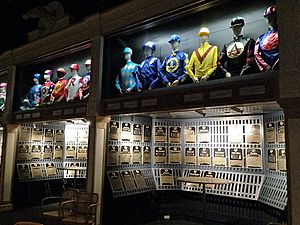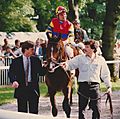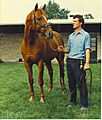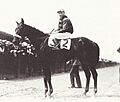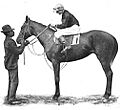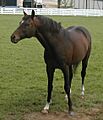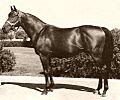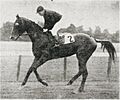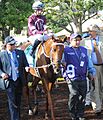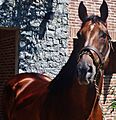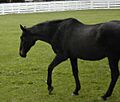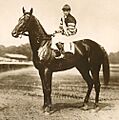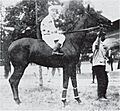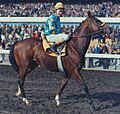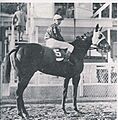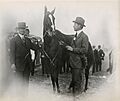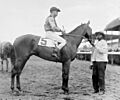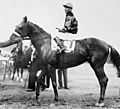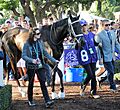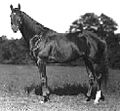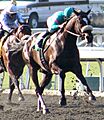National Museum of Racing and Hall of Fame facts for kids
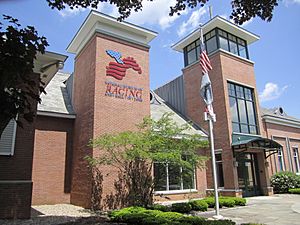
National Museum of Racing and Hall of Fame
|
|
| Established | 1951 |
|---|---|
| Location | Saratoga Springs, New York |
| Type | Professional sports hall of fame |
The National Museum of Racing and Hall of Fame is a special place in Saratoga Springs, New York. It was started in 1950 to celebrate amazing American Thoroughbred race horses, jockeys (the riders), and trainers.
In 1955, the museum moved to its current spot near the famous Saratoga Race Course. That's when they started adding people and horses to the Hall of Fame. Every spring, usually in May, they announce who will be joining the Hall of Fame. The official ceremonies happen in August during the Saratoga race season.
A special group chooses candidates for the Hall of Fame from different categories like male horses, female horses, jockeys, and trainers. Voters can pick more than one person or horse from a category. For example, in 2016, two famous female horses, Rachel Alexandra and Zenyatta, were inducted at the same time!
The museum also has a huge collection of art, old items, and cool stuff that shows the history of horse racing. This collection goes all the way back to the 1700s!
Contents
History of the Museum
The National Museum of Racing was created in 1950. A group of people who loved thoroughbred racing, led by Cornelius Vanderbilt Whitney, helped make it happen. The museum first opened in 1951 in just one room at the Canfield Casino in Saratoga.
The city of Saratoga Springs helped out with money, and the Saratoga Racing Association also donated funds. Many racing fans gave their own art and special items to the museum. The very first item in the museum's collection was a horseshoe worn by a famous horse named Lexington.
In 1955, the museum moved to its current home on Union Avenue. This new building was built just for the museum and included the Thoroughbred Racing Hall of Fame. Since then, the museum has grown several times. This allowed them to show off their large art collection and add more interactive displays about the history of horse racing.
Horses in the Hall of Fame
When the Hall of Fame first started, experts in racing history decided which horses to include. In 1955, nine horses from the earliest days of American racing were inducted. The next year, 11 horses from around the early 1900s were added. After that, fewer horses were inducted each year, focusing more on recent champions.
Today, a horse must have been retired from racing for at least five full years to be considered for the Hall of Fame. Sometimes, there are special exceptions. For example, Secretariat was inducted the year after he retired, and Ruffian was inducted the year after she passed away. Horses can be considered for the "contemporary" category for up to 25 years after their last race.
After 25 years, a special committee called the Historic Review Committee looks at horses, jockeys, and trainers from different time periods. They do this every three years.
Many incredible horses have been inducted into the Hall of Fame, celebrating their amazing careers and achievements on the track.
Jockeys in the Hall of Fame
jockeys are the talented riders who guide the racehorses. They can become eligible for the Hall of Fame after they have been licensed to ride for at least 20 years. They remain eligible for 25 years after they retire. If a jockey's career was shorter but still amazing, there might be a five-year waiting period after they retire.
The Hall of Fame honors jockeys who have shown incredible skill, courage, and success throughout their careers. Many famous jockeys have been inducted, recognized for their numerous wins and the special horses they rode.
Trainers in the Hall of Fame
Trainers are the people who prepare horses for racing. They teach them, keep them healthy, and plan their races. Trainers can be considered for the Hall of Fame after they have been licensed for at least 25 years. They remain eligible for 25 years after they retire.
Sometimes, if a trainer has health issues, the 25-year rule might be changed, but there's usually a five-year waiting period after they retire. The Hall of Fame celebrates trainers who have had a huge impact on horse racing, guiding many champions to victory.
Museum Exhibits
Besides the Hall of Fame, the museum has many cool exhibits to explore. These include:
- The Link Gallery, which has a bronze statue called Seasick and a changing display of paintings.
- The Sculpture Gallery, where you can see amazing sculptures by different artists. This gallery looks out onto a courtyard with a life-size bronze statue of the famous horse Secretariat.
- The Colonial Gallery, which teaches about how horses were brought across the ocean and how American racing first began.
- The Pre-Civil War Gallery, showing how horse racing grew in the early 1800s.
- The Post-Civil War Gallery, which covers racing's growth after the Civil War.
- The 20th Century Gallery, focusing on more recent racing history.
- The Eclipse Gallery, displaying winning photos from the Eclipse Award photography contest.
- The Racing Day Gallery, with displays about jockeys, betting odds, and the Breeders' Cup races.
- The Anatomy Room, where you can learn about how Thoroughbred horses are bred and their biology.
- The Triple Crown Gallery, with information and items related to the history of the Triple Crown races.
- The Steeplechase Gallery, which tells the story of steeplechase racing (where horses jump over obstacles) in America.
- The von Stade Gallery, which shows different paintings, drawings, or photos from the museum's collection.
- The Peter McBean Gallery, which hosts special temporary shows, a "Hall of Fame Heroes" exhibit, and seasonal displays. It also has a collection of trophies and paintings from famous horses trained by John Nerud, like Gallant Man and Dr. Fager.
The museum's collection has over 300 paintings. These include paintings of early English racing and more recent champions. You can also see special trophies, like Kelso's five Jockey Club Gold Cup trophies and the Triple Crown trophies of Count Fleet.
See also
 In Spanish: Salón de la Fama de la Hípica para niños
In Spanish: Salón de la Fama de la Hípica para niños
- Australian Racing Hall of Fame
- British Steeplechasing Hall of Fame
- British National Horseracing Museum
- Canadian Horse Racing Hall of Fame
- Japan Racing Association Hall of Fame
- Harness Racing Museum & Hall of Fame
- New Zealand Racing Hall of Fame
- Aiken Thoroughbred Racing Hall of Fame and Museum
Images for kids


